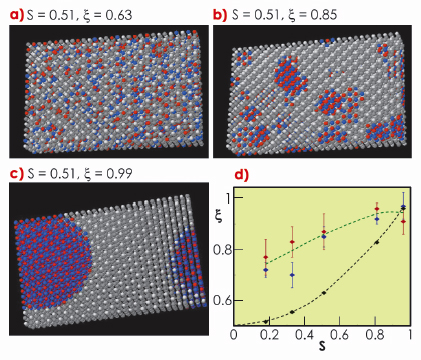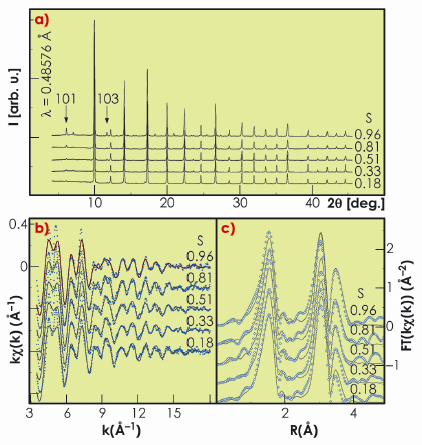- Home
- Users & Science
- Scientific Documentation
- ESRF Highlights
- ESRF Highlights 2009
- Electronic structure and magnetism
- The nature of disorder in ordered double perovskite, Sr2FeMoO6
The nature of disorder in ordered double perovskite, Sr2FeMoO6
The ideal concept of a crystalline solid as a perfect periodic structure is at the core of our understanding of a wide range of material properties. In real systems disorder is ubiquitous and is indeed complex as it can occur in many different ways in which the random distribution of defects is only a special and extreme case. As a matter of fact the physical properties of materials can be strongly influenced by the nature of the disorder, therefore they must be carefully described to properly understand the physics of complex systems. There is great interest in systems where the simultaneous presence of disorder and strong electron-electron correlation effects leads to exciting physics and potential applications. This is the case for Sr2FeMoO6 double perovskites, in which the perfect alternate occupancy of Fe and Mo sublattices gives rise to complete spin carrier polarisation, large magnetoresistance and high Curie temperature. Antisite defects, created by interchanging Fe and Mo ionic positions, affect the magnetic and magneto-transport response of this compound. The distribution of antisite defects is normally considered within the two extreme scenarios illustrated in Figure 95: homogeneously distributed (Figure 95a) or segregated in patches (Figures 95b and c), where the defects recover the original lattice periodicity but for all of the Fe ions occuping the nominal Mo sites and vice versa. Since the magnetic and magnetotransport properties of Sr2FeMoO6 are profoundly affected by the extent of disorder, we are interesting in discovering the nature of such disorder. The long range order parameter S, obtained from X-ray powder diffraction (XRPD) data, accounts for the number of antisite defects, in term of probability of Fe(Mo) on the Mo(Fe) sublattice, but cannot distinguish a homogeneous distribution from a defect segregation model; in the literature, the former is generally implicitly assumed. X-ray absorption fine structure spectroscopy (XAFS) is a local probe which allows the direct measurement of the probability ![]() to have ordered configurations (Fe-Mo pairs) around the absorber. In case of completely random defect distribution, this probability is
to have ordered configurations (Fe-Mo pairs) around the absorber. In case of completely random defect distribution, this probability is ![]() Rand= (S2+1)/2, values of
Rand= (S2+1)/2, values of ![]() greater than
greater than ![]() Rand would mean defect segregation. To understand the nature of disorder in Sr2FeMoO6 compounds, five samples were synthesised with different degrees of long range order and investigated by XRPD and XAFS (Fe and Mo K edges) at BM08, the GILDA beamline. The XRPD pattern analysis show S in between 0.18 and 0.96 (Figure 96a). Despite the ample differences in long range order, the XAFS spectra (Figures 96b and 96c) are all similar. This observation suggests that a high degree of Fe/Mo local order is preserved even when the long range disorder is excessively high. Accordingly, the quantitative analysis of XAFS spectra resulted in the experimental
Rand would mean defect segregation. To understand the nature of disorder in Sr2FeMoO6 compounds, five samples were synthesised with different degrees of long range order and investigated by XRPD and XAFS (Fe and Mo K edges) at BM08, the GILDA beamline. The XRPD pattern analysis show S in between 0.18 and 0.96 (Figure 96a). Despite the ample differences in long range order, the XAFS spectra (Figures 96b and 96c) are all similar. This observation suggests that a high degree of Fe/Mo local order is preserved even when the long range disorder is excessively high. Accordingly, the quantitative analysis of XAFS spectra resulted in the experimental ![]() (measured at the Fe and Mo K edges) to be always higher than
(measured at the Fe and Mo K edges) to be always higher than ![]() Rand (Figure 95d). To obtain further details of the local disorder of Sr2FeMoO6, we built 3D models of a cubic lattice in which Fe and Mo are arranged on different sublattices (Figures 95a-c). Antisite defects were introduced accordingly to the experimental S and were organised in antiphase regions with average diameter D. The size of antiphase regions were refined in order to fit the short range parameter of the model
Rand (Figure 95d). To obtain further details of the local disorder of Sr2FeMoO6, we built 3D models of a cubic lattice in which Fe and Mo are arranged on different sublattices (Figures 95a-c). Antisite defects were introduced accordingly to the experimental S and were organised in antiphase regions with average diameter D. The size of antiphase regions were refined in order to fit the short range parameter of the model ![]() D to the experimental values
D to the experimental values ![]() obtained by XAFS. Such modelling establishes that the antiphase domains have dimensions around 1 nm and are weakly affected by changes of S. Previous magnetic studies as a function of disorder suggested that the presence of multiple nanosized antiphase domains is more likely than highly extended domains with relatively fewer number of antiphase boundaries. This theory is definitively confirmed by the present results.
obtained by XAFS. Such modelling establishes that the antiphase domains have dimensions around 1 nm and are weakly affected by changes of S. Previous magnetic studies as a function of disorder suggested that the presence of multiple nanosized antiphase domains is more likely than highly extended domains with relatively fewer number of antiphase boundaries. This theory is definitively confirmed by the present results.
 |
|
Fig. 95: a-c) slices of 3D models of Fe/Mo cubic lattice with the same long-range order parameter (S) and different order probability ( |
 |
|
Fig. 96: a) X-ray powder diffraction data for the investigated samples: the intensity of the superlattice peaks (101, 103) is related to the long range order parameter S. b) the Mo K edge XAFS data and c) their Fourier transforms. Blue points and dark lines are respectively the experimental data and the best fits. |
Our study demonstrates that a high degree of cation order is preserved locally even in samples with a high degree of long range disorder. The structural simulations suggest that the formation of antiphase patches is favoured over the homogeneous distribution of antisite defects. Therefore, the short and long range order features in Sr2FeMoO6 can be understood in terms of locally ordered regions forming nanosized antiphase domains. This peculiar “disorder” profoundly affects magnetic properties of this interesting material.
Principal publication and authors
C. Meneghini (a,b), S. Ray (c,d), F. Liscio (a), F. Bardelli (a,b), S. Mobilio (a,b,e) and D.D. Sarma (c,d), Phys. Rev. Lett. 103, 046403 (2009).
(a) Dipartimento di Fisica, Universita di Roma Tre (Italy)
(b) CNR TASC Laboratory c/o GILDA-ESRF Grenoble (France)
(c) Indian Institute of Science, Bangalore (India)
(d) Indian Association for the Cultivation of Science, Kolkata (India)
(e) Laboratori Nazionali di Frascati dell’INFN (Italy)



